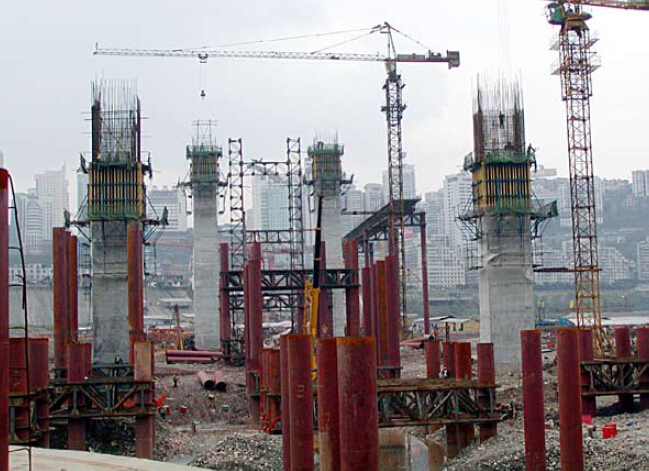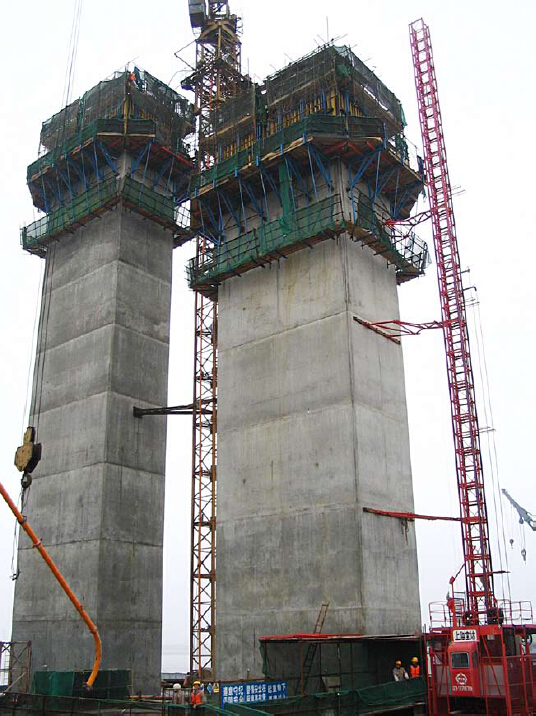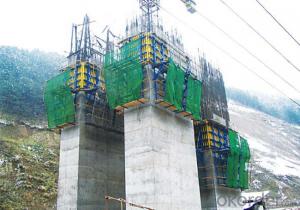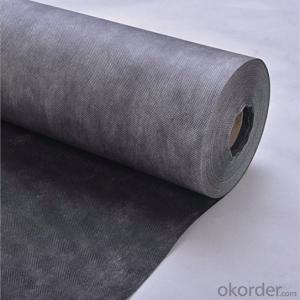Climbing Bracket CB240 for Formwork and Scaffolding Systems
- Loading Port:
- Tianjin
- Payment Terms:
- TT OR LC
- Min Order Qty:
- 50 m²
- Supply Capability:
- 1000 m²/month
OKorder Service Pledge
OKorder Financial Service
You Might Also Like
Climbing Bracket CB240 & CB210
They are framework brackets for supporting large-area wall formwork.
Typical applications for the CB240&CB210 are pier and column/shear wall/core walll/ in the
building.
CB210 has smaller size than CB240, it will be cost effective in some condition.
Characteristics:
◆ High bearing capacity
The high loading capacity of the brackets allow very large scaffold units. This saves the number
anchor points required as well as reducing climbing times.
◆ Simple moving procedure by crane
Through the strong connection of formwork together with the climbing scaffold, both can be moved
as a single climbing unit by crane. Thus valuable time-savings can be achieved.
◆ Fast striking process without a crane
With the retrusive set, large formwork elements can also be retracted quickly and a minimum of
effort.
◆ Safe with work platform
The platforms have assembled firmly with bracket and will be climbing together, without scaffolding
but can work safely in spite of your high location.


- Q:How does steel formwork impact the overall project budgeting?
- Steel formwork can have a significant impact on the overall project budgeting. While it may have a higher upfront cost compared to other formwork materials, such as timber or plastic, steel formwork offers several benefits that can ultimately result in cost savings. Its durability and reusable nature allow for multiple project uses, reducing the need for frequent replacements or repairs. Additionally, steel formwork provides better precision and structural stability, leading to improved construction quality and reduced material waste. These factors, combined with increased productivity due to faster assembly and dismantling times, can contribute to a more efficient construction process and ultimately lower overall project costs.
- Q:Can steel formwork be used for structures with high thermal insulation requirements?
- Structures that require high thermal insulation typically do not employ steel formwork. This is due to steel's high heat conductivity, which facilitates heat transfer. Consequently, using steel formwork in such structures would result in significant heat loss and reduce the building's overall energy efficiency. To achieve optimal thermal insulation, materials with excellent thermal resistance, such as insulating concrete forms (ICFs), expanded polystyrene (EPS), or other insulated formwork systems, are preferred. These materials possess low thermal conductivity and serve as barriers against heat transfer. By utilizing these materials, structures can fulfill the demanding thermal insulation requirements and enhance energy efficiency. Nevertheless, it is important to note that steel formwork can still be utilized in conjunction with insulation materials to provide structural support and shape the structure. In this scenario, additional insulation measures, such as the application of insulation layers or the utilization of insulation inserts, would be necessary to augment the thermal performance of the structure. In conclusion, while steel formwork may be suitable for various construction projects, it is not the optimal choice for structures that necessitate high thermal insulation.
- Q:Are there any specific maintenance requirements for steel formwork?
- Steel formwork has specific maintenance requirements that must be followed to ensure its optimal performance and durability. Cleaning the formwork after each use is crucial. This involves thoroughly removing any concrete residue and preventing the accumulation of corrosive agents. A mild detergent and water can be used for cleaning, followed by proper drying of all surfaces. Inspecting the formwork for any signs of damage or wear is also important. This includes checking for cracks, rust, or any other defects that could weaken the structure. Prompt repair or replacement of damaged components is necessary to maintain the formwork's integrity and safety. Proper storage and handling practices are essential for steel formwork maintenance. The formwork should be stored in a dry and well-ventilated area to prevent corrosion. Protection from moisture, extreme temperatures, and direct sunlight is necessary. When handling the formwork, abrasive materials or tools that could cause scratches or dents should be avoided. Regular lubrication of moving parts, such as hinges and locks, is recommended. This ensures smooth operation and prevents seizing or jamming. Using a suitable lubricant reduces friction and extends the life of these components. Lastly, it is advisable to follow the manufacturer's guidelines and recommendations for specific maintenance requirements of the steel formwork. These guidelines may include additional steps or precautions that are specific to the formwork system being used. By adhering to these maintenance requirements, steel formwork can be kept in excellent condition, allowing for efficient and safe construction practices.
- Q:What are the common safety precautions when working with steel formwork in high winds?
- When working with steel formwork in high winds, there are several common safety precautions that should be followed to ensure the safety of workers and the integrity of the formwork. 1. Secure the formwork: It is essential to properly secure the steel formwork to prevent it from being blown away by strong winds. This can be achieved by using appropriate anchoring methods such as tie-downs, braces, or clamps. Adequate bracing should be installed at regular intervals to provide additional stability. 2. Regular inspections: Regular inspections of the formwork should be conducted before, during, and after high wind events. This includes checking for any signs of damage or weakness in the formwork structure, loose connections, or compromised anchoring. Any issues identified should be addressed promptly to prevent accidents or further damage. 3. Reinforce the formwork: In areas with high wind activity, it may be necessary to reinforce the steel formwork to withstand the stronger forces. This can be done by adding additional support beams, cross-bracing, or wind-resistant features to the structure. The reinforcement should be designed and implemented by a qualified engineer to ensure its effectiveness. 4. Provide personal protective equipment (PPE): Workers should be provided with appropriate personal protective equipment to protect them from potential hazards during high wind conditions. This may include safety helmets, goggles, gloves, and high-visibility clothing to enhance visibility for other workers and equipment operators. 5. Monitor weather conditions: Regular monitoring of weather conditions is crucial when working with steel formwork in high winds. If there are predictions or signs of strong winds, work should be temporarily suspended until the wind speeds decrease to safe levels. It is important to have a reliable weather monitoring system in place to stay informed about changing weather conditions. 6. Training and communication: All workers involved in working with steel formwork should receive proper training on the safety precautions and procedures to follow during high wind situations. Clear communication channels should be established to ensure that workers are aware of any changes in weather conditions or safety protocols. By following these common safety precautions, the risks associated with working with steel formwork in high winds can be minimized, ensuring the well-being of workers and the successful completion of the construction project.
- Q:What are the main components of a steel formwork system?
- The main components of a steel formwork system typically include panels, connectors, clamps, pins, and wedges.
- Q:Is steel formwork suitable for projects with high concrete strength requirements?
- Yes, steel formwork is suitable for projects with high concrete strength requirements. Steel formwork is known for its high strength and durability, making it ideal for projects that require high concrete strength. It can withstand the pressure and weight of the concrete, ensuring that it maintains its shape and stability during the pouring and curing process. Additionally, steel formwork provides a smooth and uniform finish to the concrete, which is important for achieving high strength and quality in the final product. Moreover, steel formwork can be easily reused multiple times, making it a cost-effective option for projects with high concrete strength requirements.
- Q:How does steel formwork affect the overall cost of concrete construction?
- Steel formwork can increase the overall cost of concrete construction due to its higher initial investment compared to other formwork materials. However, it offers several advantages such as durability, reusability, and better quality finishes, which can result in cost savings in the long run by reducing the need for frequent replacements and rework. Additionally, steel formwork allows for faster construction and improved productivity, which can offset the initial cost by reducing labor expenses and project timelines.
- Q:Can steel formwork be used for heritage restoration projects?
- Yes, steel formwork can be used for heritage restoration projects. Steel formwork offers durability, strength, and flexibility, making it suitable for various construction projects, including heritage restoration. It can be customized to fit the unique requirements of each project and provides a solid structure for concrete placement. Additionally, steel formwork allows for easy removal and reusability, making it a cost-effective choice for heritage restoration projects.
- Q:How does steel formwork improve the quality of concrete structures?
- Steel formwork improves the quality of concrete structures by providing a strong and durable framework that ensures accurate and precise shaping of the concrete. It offers better control over the dimensions and shape of the structure, resulting in a higher level of precision and consistency in the final product. Additionally, steel formwork has a smooth surface that reduces the chances of surface defects and improves the aesthetic appeal of the concrete structure.
- Q:How does steel formwork affect the overall construction site organization?
- Steel formwork can have a significant impact on the overall organization of a construction site. Firstly, steel formwork is known for its durability and reusability, which means it can be used multiple times for different projects. This allows for better planning and scheduling of construction activities, as the availability of formwork is more predictable and reliable. Additionally, steel formwork is known for its precision and accuracy, which leads to better quality construction. This can result in fewer reworks and delays, as the formwork ensures that concrete is poured in the right place and to the correct dimensions. Consequently, the overall construction process becomes more efficient, allowing for better organization and coordination of various trades and activities on the site. Steel formwork also offers flexibility in design and construction. It can be easily adjusted and modified to accommodate changes in the project, such as alterations in the shape or size of concrete elements. This adaptability reduces the need for additional materials and resources, which can streamline the organization of the construction site and minimize waste. Furthermore, steel formwork is known for its strength and stability. This allows for taller and larger concrete structures to be constructed, which can have implications for the overall layout and organization of the site. For example, it may require additional crane or lifting equipment to handle the heavier and larger formwork components. This necessitates careful planning and coordination to ensure that the site is properly organized to accommodate these requirements. In summary, steel formwork positively impacts the overall organization of a construction site by providing durability, precision, flexibility, and strength. These attributes contribute to better planning, scheduling, and coordination of construction activities, resulting in improved efficiency, quality, and adaptability.
1. Manufacturer Overview |
|
|---|---|
| Location | |
| Year Established | |
| Annual Output Value | |
| Main Markets | |
| Company Certifications | |
2. Manufacturer Certificates |
|
|---|---|
| a) Certification Name | |
| Range | |
| Reference | |
| Validity Period | |
3. Manufacturer Capability |
|
|---|---|
| a)Trade Capacity | |
| Nearest Port | |
| Export Percentage | |
| No.of Employees in Trade Department | |
| Language Spoken: | |
| b)Factory Information | |
| Factory Size: | |
| No. of Production Lines | |
| Contract Manufacturing | |
| Product Price Range | |
Send your message to us
Climbing Bracket CB240 for Formwork and Scaffolding Systems
- Loading Port:
- Tianjin
- Payment Terms:
- TT OR LC
- Min Order Qty:
- 50 m²
- Supply Capability:
- 1000 m²/month
OKorder Service Pledge
OKorder Financial Service
Similar products
New products
Hot products
Hot Searches

























